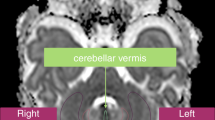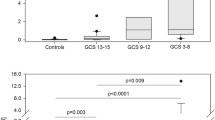Abstract
Research in neuroscience relies heavily upon postmortem human brain tissue. Cerebellar granular layer autolysis (GLA) is a surrogate marker for the quality of such tissue and suitability for molecular analysis. GLA is associated with reduced brain tissue pH. The aim of this study was to assess correlation of GLA with premortem systemic acid–base status. This is a retrospective study in which 62 consecutive adult autopsy cases were included. Sections of cerebellum were reviewed microscopically for presence of GLA. Autolysis was graded as negative, grade 1, grade 2, and grade 3. Medical records were reviewed for arterial blood gas analysis. Postmortem interval was recorded. 23 of 62 cases showed GLA. Of the 23 patients with autolysis, 22 were acidotic and 1 was alkalotic. Of these 23 cases, 15 had metabolic acidosis, 4 had respiratory acidosis, 3 had combined acidosis and 1 had respiratory alkalosis. There was no statistically significant difference in postmortem interval between the two groups. 10 cases with grade 3 autolysis had mean pH of 7.13, 7 cases with grade 2 autolysis had mean pH of 7.23 and in 6 cases with grade 1 autolysis the mean pH was 7.2. Overall, the mean pH in patients with GLA was 7.19, and in the non-autolytic cases the mean pH was 7.28 (P < 0.05). There was no correlation between the degree of acidosis and severity of autolysis. GLA is associated with premortem systemic acidosis, and premortem systemic alkalosis is associated with the absence of GLA. Premortem acid–base status may serve as an additional quality indicator for assessment of tissue for research.




Similar content being viewed by others
References
Albrechtsen R (1977a) Naphthylamidase used as a lysosome marker in the study of acute selective necrosis of the internal granular layer of cerebellum. Acta Pathol Microbiol Scand A 85(6):875–888
Albrechtsen R (1977b) The incidence of the so-called acute selective necrosis of the granular layer of cerebellum in 1000 autopsied patients. Acta Pathol Microbiol Scand A 85A(2):193–202
Albrechtsen R, Jensen H (1975) Histochemical demonstration of an LNA-splitting enzyme in the cerebellum of the rat. A aminopeptidase-like reaction localized selectively in the granular layer with acid pH optimum. Acta Pathol Microbiol Scand A 83(5): 503–510
Barton AJ, Pearson RC, Najlerahim A, Harrison PJ (1993) Pre- and postmortem influences on brain RNA. J Neurochem 61(1):1–11
Gilmore JH, Lawler CP, Eaton AM, Mailman RB (1993) Postmortem stability of dopamine D1 receptor mRNA and D1 receptors. Brain Res Mol Brain Res 18(4):290–296
Hardy JA, Wester P, Winblad B, Gezelius C et al (1985) The patients dying after long terminal phase have acidotic brains; implications for biochemical measurements on autopsy tissue. J Neural Transm 61(3–4):253–264
Harrison PJ, Heath PR, Eastwood SL, Burnet PW et al (1995) The relative importance of premortem acidosis and postmortem interval for human brain gene expression studies: selective mRNA vulnerability and comparison with their encoded proteins. Neurosci Lett 200(3):151–154
Johnston NL, Cervenak J, Shore AD, Torrey EF et al (1997) Multivariate analysis of RNA levels from postmortem human brains as measured by three different methods of RT-PCR. Stanley Neuropathology Consortium. J Neurosci Methods 77(1):83–92
Kingsbury AE, Foster OJ, Nisbet AP, Cairns N et al (1995) Tissue pH as an indicator of mRNA preservation in human post-mortem brain. Brain Res Mol Brain Res 28(2):311–318
Lipska BK, Deep-Soboslay A, Weickert CS, Hyde TM et al (2006) Critical factors in gene expression in postmortem human brain: focus on studies in schizophrenia. Biol Psychiatry 60(6):650–658
Ravid R, Van Zwieten EJ, Swaab DF (1992) Brain banking and the human hypothalamus–factors to match for pitfalls and potentials. Prog Brain Res 93:83–95
Schroeder A, Mueller O, Stocker S, Salowsky R et al (2006) The RIN: an RNA integrity number for assigning integrity values to RNA measurements. BMC Mol Biol 7:3
Sheedy D, Harding A, Say M, Stevens J, Kril J (2012) Histological assessment of cerebellar granular cell layer in postmortem brain, a useful marker of tissue integrity? Cell Tissue Bank 13(4):521–527
Sheedy D, Garrick T, Dedova I, Hunt C et al (2008) An Australian Brain Bank: a critical investment with a high return! Cell Tissue Bank 9(3):205–216
Tomita H, Vawter MP, Walsh DM, Evans SJ et al (2004) Effect of agonal and postmortem factors on gene expression profile: quality control in microarray analyses of postmortem human brain. Biol Psychiatry 55(4):346–352
Weis S, Llenos IC, Dulay JR, Elashoff M et al (2007) Quality control for microarray analysis of human brain samples: the impact of postmortem factors RNA characteristics and histopathology. J Neurosci Methods 165(2):198–209
Author information
Authors and Affiliations
Corresponding author
Additional information
Publisher's Note
Springer Nature remains neutral with regard to jurisdictional claims in published maps and institutional affiliations.
Rights and permissions
About this article
Cite this article
Agarwal, A.N., Gilbert, A.R. & Mais, D.D. Correlation of cerebellar granular layer autolysis with ante-mortem systemic acid–base status. Cell Tissue Bank 22, 505–509 (2021). https://doi.org/10.1007/s10561-021-09900-4
Received:
Accepted:
Published:
Issue Date:
DOI: https://doi.org/10.1007/s10561-021-09900-4




